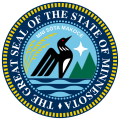| |||||||||||||||||||||
| |||||||||||||||||||||
| |||||||||||||||||||||
The 1920 Minnesota Attorney General election was held on November 2, 1920, in order to elect the attorney general of Minnesota. Republican nominee and incumbent attorney general Clifford L. Hilton defeated Independent candidate Thomas V. Sullivan and Democratic nominee Raymond A. McQuat. [1]


